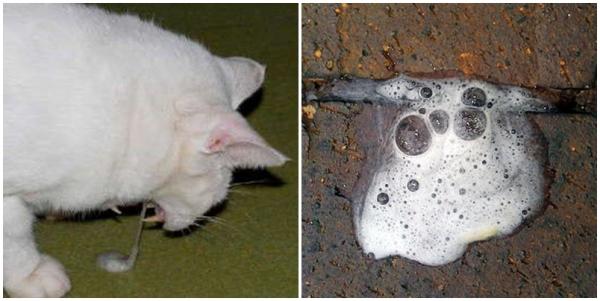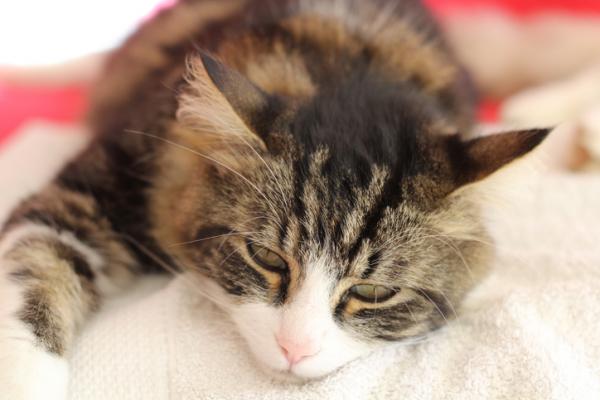Why does my cat vomit white foam?

Although many caregivers think it is normal for cats to vomit frequently, the fact is that acute episodes of vomiting or recurrent vomiting over time are always a reason for veterinary consultation and can have many different causes. In this article we will focus on describing the most common when explaining why our cat vomits white foam.
It is good that we observe if the vomit is of acute course (many vomiting in a short time) or chronic (1-2 daily vomiting or almost not remitting) and if, in addition, there are other symptoms such as diarrhea, to communicate it to the vet.
Gastrointestinal causes of foam vomit
The simplest motive behind vomiting is going to be a Irritation of the digestive system, which can have different causes. At the time of diagnosis it is important to take into account, in addition to whether the vomiting is sporadic or persistent and whether or not there are other symptoms, as we have already said, the content of the vomit, since this can be foam, food, blood or even parasites. In the article we will focus on why the cat vomits white foam.
Some of the gastrointestinal causes are the following:
- Gastritis: gastritis in cats can be both acute and chronic and, in both cases, will require veterinary assistance. In gastritis irritation of the stomach wall occurs, as when a substance such as grass, some foods, drugs or toxic substances are ingested, therefore, intoxication in cats is another cause of gastritis. When this is chronic we can see that the mantle of our cat is losing quality. If it is not treated, we will also appreciate weight loss. In younger cats, food allergy may be behind gastritis. For all this it must be our veterinarian who identifies the specific cause and prescribes the corresponding treatment.
- Strange bodies: in cats, the typical example is the hair balls, especially in the molting season. Sometimes this hair ends up forming, inside the digestive system, hard balls, known as trichobezoars, which can become so large that they can not leave by themselves. Thus, the presence of foreign bodies can cause irritation of the digestive system but also an obstruction or even an intussusception (introduction of a segment of the intestine in the intestine itself), in which case a surgical intervention would be necessary.
- Inflammatory bowel disease: it is one of the most common causes of vomiting in cats and should be differentiated from other pathologies such as lymphoma. Our veterinarian will be responsible for carrying out the relevant tests. In these cases we can see that the cat vomits white foam and has diarrhea or, at least, decomposition, in a chronic way, that is, it does not correct itself with the passage of time.
Finally, note that one of the most common infectious diseases of the gastrointestinal system, feline panleukopenia, is vomiting and profuse diarrhea, but in this case, they are usually bloody. In addition, the cat will usually have a fever, will be off and will not eat. This state supposes a veterinary urgency.

Other causes of foam vomiting
Sometimes, the cause that will explain why our cat vomits white foam will not be in the stomach or intestine, but in several diseases that affect organs such as the liver, pancreas or kidney. Some of these conditions are the following:
- Pancreatitis: Feline pancreatitis can occur for different reasons and all will require veterinary treatment. It occurs acutely or, more frequently, chronically and may concur with other diseases, such as gastrointestinal, liver, diabetes, etc. It consists of inflammation or swelling of the pancreas, an organ responsible for producing enzymes for digestion and insulin to metabolize sugar. Among the symptoms are vomiting but also diarrhea, thinning and a coat in poor condition.
- Liver failure: the liver fulfills important functions such as the elimination of waste or metabolism. A failure in its functioning will cause symptoms, many of them unspecific, such as vomiting, lack of appetite or weight loss. In more advanced cases jaundice occurs in cats, which is the yellowing of mucous membranes and skin. Several diseases, toxins or tumors can affect the liver, so the diagnosis and veterinary treatment will be essential.
- DiabetesDiabetes in cats is a common disease in cats over 6 years, is characterized by inadequate production of insulin, which is the substance responsible for getting glucose to the cells. Without insulin, glucose accumulates in the blood and symptoms develop. The most usual thing is that we see that our cat drinks, eats and urinates more, although it does not get fat, but vomiting, alterations in the fur, bad breath, etc. can also occur. The strict treatment should be established by the veterinarian.
- Renal: Kidney failure in cats is a very common disorder in elderly cats. Kidney damage can also occur acutely or chronically. Chronic renal failure can not be cured but it can be treated to keep the cat with the best quality of life possible. Therefore it is essential to go to the veterinarian as soon as we observe symptoms such as a considerable increase in water intake, a change in the excretion of urine, loss of appetite, dehydration, mantle in poor condition, dull mood, weakness, wounds in the mouth, breath with strange odor or vomit. Acute cases require urgent veterinary attention.
- Hyperthyroidism: the thyroid gland is located in the neck and is responsible for producing thyroxine. Its excess implies the development of a clinical picture, especially in cats older than 10 years, which will consist of weight loss, significant increase in activity (we will notice that the cat does not stop), increase in food and water intake, vomiting, diarrhea, greater elimination of urine and, also, more vocalizations, that is, the cat will be more “talkative”. As always, it will be the veterinarian who, after the relevant tests, diagnoses the disease.
- Parasites: If our kitten vomits white foam and we have not dewormed it internally it can be infested with internal parasites. In these cases we may also observe that the kitten vomits white foam and does not eat or also presents diarrhea, all these discomforts caused by the action of the parasites. As we say, this situation is more likely to occur in kittens than in adults, since they are more resistant to parasites. Our veterinarian will recommend some of the best products to deworming cats.
If we look, most of these diseases have similar symptoms, so it’s basic see our veterinarian Without delay because, as we have said, frequent vomiting in cats is not normal and we must identify the disease that causes them as soon as possible to start treatment.
Avoid and treat foam vomiting
Once exposed the most common causes that explain why a cat vomits white foam, we will see some recommendations about what we can do to prevent and act in this situation. They are the following:
- Vomiting is a symptom that we should not leave without treatment, going to our reference veterinarian.
- It is a good idea to write down the symptoms that we observe. In the case of vomiting, we should look at its composition and frequency. With this we will help the veterinarian to reach a diagnosis.
- We must provide our cat with an adequate diet for its nutritional needs, avoiding foods that may make it feel bad or provoke an allergic reaction.
- We also have to keep it in a safe environment to prevent it from being swallowed by a potentially dangerous object.
- As for the hair balls, it is convenient that we brush our cat, especially during the molting season, since this way we help eliminate all the dead hair that has to fall. We can also count on the help of malt for cats or feed specially formulated to favor hair transit.
- It is important to maintain a calendar of internal and external deworming, even when our cat does not have access to the outside. Our veterinarian will give us the most appropriate guidelines according to our circumstances.
- If our cat vomits once and is in good spirits, we can wait, observing, before contacting the veterinarian. On the contrary, if the vomiting is repeated, we see other symptoms or we see our decayed cat, we must go directly to the veterinarian, without trying to treat it on our own.
- Finally, from the 6-7 years of age it is convenient that, at least once a year, we take our cat to the veterinary clinic for a Full review that includes analytics. This is justified because in these controls some of the diseases that we have talked about can be diagnosed at an early stage, which allows us to start the treatment before the first symptoms appear.

This article is merely informative, in .com we do not have the faculty to prescribe veterinary treatments or make any kind of diagnosis. We invite you to take your pet to the veterinarian in case of any type of condition or discomfort.
If you want to read more articles similar to Why does my cat vomit white foam?, we recommend that you enter in our section of Other health problems.


